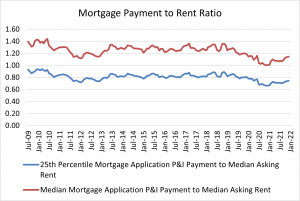Median Mortgage Application Payment Jumped 8.3 Percent in February to $1,653

Homebuyer affordability decreased in February, with the national median payment applied for by applicants jumping 8.3 percent to $1,653 from $1,526 in January. This is according to the Mortgage Bankers Association’s (MBA) new Purchase Applications Payment Index (PAPI), which measures how new monthly mortgage payments vary across time – relative to income – using data from MBA’s Weekly Applications Survey (WAS).
“Low unemployment has spurred strong income growth in early 2022, but homebuyer affordability has decreased due to the quick rise in mortgage rates amidst steep home-price growth,” said Edward Seiler, MBA’s Associate Vice President, Housing Economics, and Executive Director, Research Institute for Housing America. “The 30-year fixed-rate mortgage spiked 73 basis points from December 2021 through February 2022. Together with increased loan application amounts, a mortgage applicant’s median principal and interest payment in February jumped $127 from January and $337 from one year ago.”
An increase in MBA’s PAPI – indicative of declining borrower affordability conditions – means that the mortgage payment to income ratio (PIR) is higher due to increasing application loan amounts, rising mortgage rates, or a decrease in earnings. A decrease in the PAPI – indicative of improving borrower affordability conditions – occurs when loan application amounts decrease, mortgage rates decrease, or earnings increase.
The national PAPI (Figure 1) increased 8.3 percent to 146.3 in February 2022 from 135.1 in January 2022, meaning payments on new mortgages take up a larger share of a typical person’s income. Compared to February 2021 (120.0), the index jumped 21.9 percent. For borrowers applying for lower-payment mortgages (the 25th percentile), the national mortgage payment increased 9.8 percent to $1,094 from $996 in January 2022.
MBA’s national mortgage payment to rent ratio (MPRR) – this month comparing median purchase mortgage application payments to median asking rents in December 2021 from November 2021 – increased to 1.15 from 1.14 and was up from 1.01 in December 2020, meaning mortgage payments for home purchases have increased relative to rents. The national median asking rent in fourth-quarter 2021 was $1,207. The 25th percentile mortgage application payment to median asking rent ratio increased from 0.73 in November 2021 to 0.74 in December 2021.
Added Seiler, “Asking rents from first-quarter 2020 to fourth-quarter 2021 increased 16 percent, even outpacing the steep growth in mortgage application payments over that period. MBA’s mortgage payment to rent ratio is now at roughly the same level it was at the start of the COVID-19 pandemic in March 2020.”
Additional Key Findings of MBA’s Purchase Applications Payment Index (PAPI) – February 2022
- The national median mortgage payment applied for by applicants was $1,653 in February, up from $1,526 in January, $1,383 in December 2021, and $1,316 in February 2021.
- The national median mortgage payment for FHA loan applicants was $1,201 in February, up from $1,142 in January and $1,009 in February 2021.
- The national median mortgage payment for conventional loan applicants was $1,749 in February, up from $1,582 in January and $1,391 in February 2021.
- The top five states with the highest PAPI were: Idaho (221.3), Nevada (216.5), Arizona (189.4), Utah (181.6), and Washington (180.4).
- The top five states with the lowest PAPI were: Washington, D.C. (86.3), Connecticut (91.8), Alaska (94.8), Iowa (101.2) and Wyoming (104.1).
- Homebuyer affordability decreased for Black households, with the national PAPI increasing from 140.0 in January to 151.6 in February.
- Homebuyer affordability decreased for Hispanic households, with the national PAPI increasing from 125.9 in January to 136.4 in February.
- Homebuyer affordability decreased for White households, with the national PAPI increasing from 136.6 in January to 147.9 in February.
About MBA’s Purchase Applications Payment Index
The Mortgage Bankers Association’s Purchase Applications Payment Index (PAPI) measures how new mortgage payments vary across time relative to income. Higher index values indicate that the mortgage payment to income ratio (PIR) is higher than in a month where the index is lower. Contrary to other affordability indexes that make multiple assumptions about mortgage underwriting criteria to estimate mortgage payment level, PAPI directly uses MBA’s Weekly Applications Survey (WAS) data to calculate mortgage payments.
PAPI uses usual weekly earnings data from the U.S. Bureau of Labor Statistics’ Current Population Survey (CPS). Usual weekly earnings represent full-time wage and salary earnings before taxes and other deductions and include any overtime pay, commissions, or tips usually received. Note that data are not seasonally adjusted.
The rent data series calculated for MBA’s national mortgage payment to rent ratio (MPRR) comes from the U.S. Census Bureau’s Housing Vacancies and Homeownership (HVS) survey’s median asking rent. The HVS data is quarterly, and as such, the mortgage payment to rent ratio will be updated quarterly. For additional information on MBA’s Purchase Applications Payment Index, click here.
Contact:
Adam DeSanctis – Media Contact – adesanctis@mba.org – (202) 557-2727
Source: Mortgage Bankers Association




